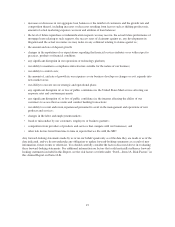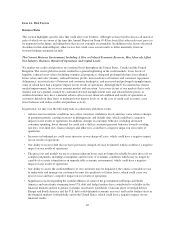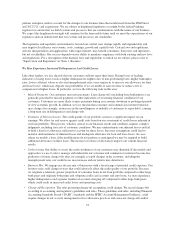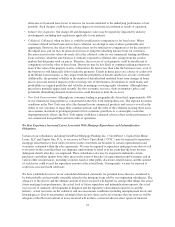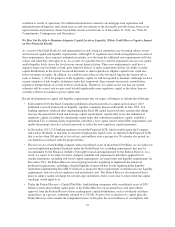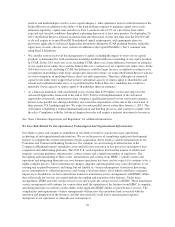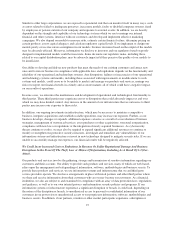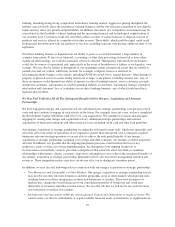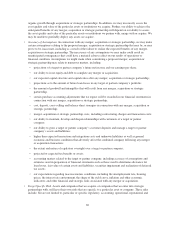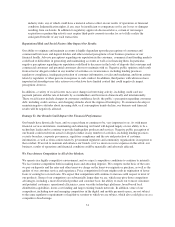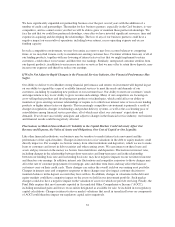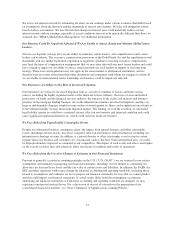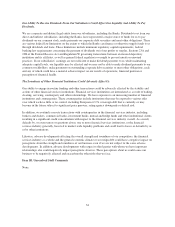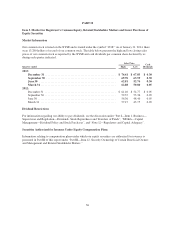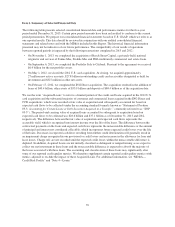Capital One 2013 Annual Report Download - page 49
Download and view the complete annual report
Please find page 49 of the 2013 Capital One annual report below. You can navigate through the pages in the report by either clicking on the pages listed below, or by using the keyword search tool below to find specific information within the annual report.banking, including facing strong competition in the direct banking market. Aggressive pricing throughout the
industry may adversely affect the retention of existing balances and the cost-efficient acquisition of new deposit
funds and may affect our growth and profitability. In addition, the effects of a competitive environment may be
exacerbated by the flexibility of direct banking and the increasing financial and technological sophistication of
our customer base. Customers could also close their online accounts or reduce balances or deposits in favor of
products and services offered by competitors for other reasons. These shifts, which could be rapid, could result
from general dissatisfaction with our products or services, including concerns over pricing, online security or our
reputation.
Our direct banking business is dependent on our ability to process, record and monitor a large number of
complex transactions. If any of our financial, accounting, or other data processing systems fail or have other
significant shortcomings, we could be materially adversely affected. Third parties with which we do business
could also be sources of operational risk, particularly in the event of breakdowns or failures of such parties’ own
systems. We may also be subject to disruptions of our operating systems arising from events that are wholly or
partially beyond our control, which may include, for example, computer viruses or electrical or
telecommunications outages, cyber-attacks, including DDOS discussed above, natural disasters, other damage to
property or physical assets or events arising from local or larger scale politics, including terrorist acts. Any of
these occurrences could diminish our ability to operate our direct banking business, service customer accounts,
and protect customers’ information, or result in potential liability to customers, reputational damage, regulatory
intervention and customers’ loss of confidence in our direct banking business, any of which could result in a
material adverse effect.
We May Fail To Realize All Of The Anticipated Benefits Of Our Mergers, Acquisitions and Strategic
Partnerships.
We have engaged in merger and acquisition activity and entered into strategic partnerships over the past several
years and may continue to engage in such activity in the future. For example, in recent years, we have completed
the Beech Street Capital, ING Direct and 2012 U.S. card acquisitions. We continue to evaluate and anticipate
engaging in, among other merger and acquisition activity, additional strategic partnerships and selected
acquisitions of financial institutions and other financial assets, including credit card and other loan portfolios.
Any merger, acquisition or strategic partnership we undertake will entail certain risks, which may materially and
adversely affect our results of operations. If we experience greater than anticipated costs to integrate acquired
businesses into our existing operations or are not able to achieve the anticipated benefits of any merger,
acquisition or strategic partnership, including cost savings and other synergies, our business could be negatively
affected. In addition, it is possible that the ongoing integration processes could result in the loss of key
employees, errors or delays in systems implementation, the disruption of our ongoing businesses or
inconsistencies in standards, controls, procedures and policies that adversely affect our ability to maintain
relationships with partners, clients, customers, depositors and employees or to achieve the anticipated benefits of
any merger, acquisition or strategic partnership. Integration efforts also may divert management attention and
resources. These integration matters may have an adverse effect on us during any transition period.
In addition, we may face the following risks in connection with any merger, acquisition or strategic partnership:
•New Businesses and Geographic or Other Markets. Our merger, acquisition or strategic partnership activity
may involve our entry into new businesses and new geographic areas or other markets which present risks
resulting from our relative inexperience in these new businesses or markets. These new businesses or
markets may change the overall character of our consolidated portfolio of businesses and could react
differently to economic and other external factors. We face the risk that we will not be successful in these
new businesses or in these new markets.
•Identification and Assessment of Merger and Acquisition Targets and Deployment of Acquired Assets. We
cannot assure you that we will identify or acquire suitable financial assets or institutions to supplement our
29


